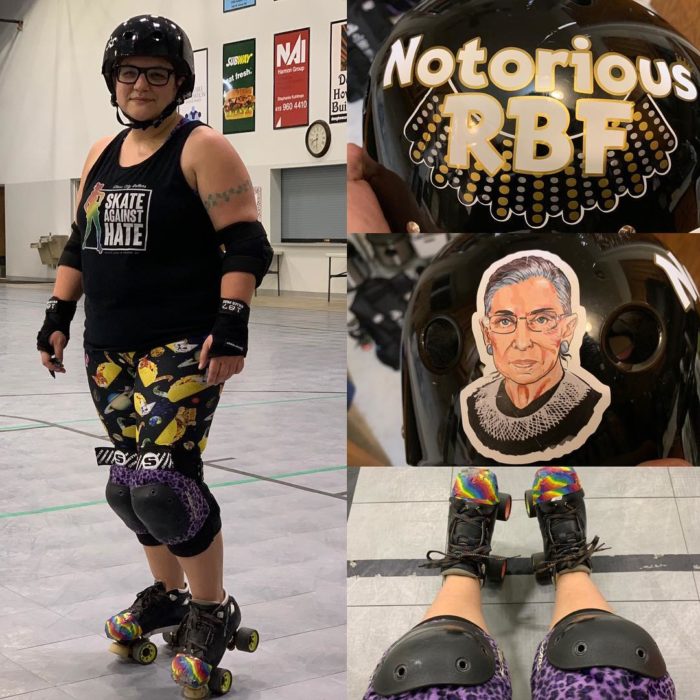In celebration of our 10th Anniversary, Bast Amron has asked each of our lawyers to write about their passion outside the law.
This month Bast Amron highlights Dana Quick. Dana practices in the area of insolvency and commercial litigation. Her experience includes prosecuting director and officer liability claims; representing trustees, creditors, creditor committees, and debtors in bankruptcy proceedings; state court insolvency litigation; and prosecuting and defending preference actions. Prior to joining Bast Amron, Dana served as a law clerk to U.S. Bankruptcy Judge Laurel Myerson Isicoff. Dana is a graduate of the University of Toledo School of Law and Eastern Michigan University. Dana’s passion, is one of our most fascinating – roller derby!

I’ve been on wheels of one form or another since kindergarten. My first set was a pair of white and pink roller skates, hand-me-downs I’m sure from my older sister or a garage sale purchase. I rolled around the block in those skates until I could no longer wedge my feet into the too small boots and the wheels were ground down to the plastic hubs. In adolescence I switched to inline skates and the occasional skateboard (though I never got the hang of the latter). Later, as an adult, aside from the occasional trip to a roller skating rink, skating mostly fell by the wayside when my kids came along. But I never lost my love for it.
About ten years ago I first heard about roller derby. I had no idea what it was, but I knew instantly it was something I wanted to try. However, it would take many years before I got the chance. But two years ago, as a 38 year old mother of 3, I laced up my skates and joined a beginner training class, appropriately and affectionately referred to as a “fresh meat” class. After learning how to put on all of our gear correctly, the second thing we learned in fresh meat was how to fall safely. And we do fall, a lot – I perhaps more so than others since I lack both athleticism and grace. As part of the fundamental skills in our fresh meat class we also learned how skate fast, get low, stop, jump (over people and other obstacles), give and receive whips, and give and receive hits, all while on roller skates.
When I mention roller derby to people of a certain age, they have vague recollections of watching something called roller derby on TV. But aside from happening on quad roller skates and having tough sounding names, roller derby is nothing like what you may have seen on TV in the past. If you haven’t seen roller derby in the last 10 years, you haven’t seen modern roller derby.
There are two main styles of roller derby currently played – banked track and flat track. Banked track roller derby requires a permanent space to host a large, banked rink. Flat track, as it sounds, is played on a flat surface, and liberties of being able to play it just about anywhere the size of a tennis court or larger has allowed this version of the sport to gain traction across the country and around the world. Indeed most any city of moderate size either has a roller derby team or is near one. For example, Florida has teams in Miami, Fort Lauderdale, Key West, Palm Beach, Jacksonville, Bradenton, Gainesville, Orlando, and Tampa.
A roller derby game, called a bout, consists of two teams playing two 30 minute halves, which is broken down into jams that can last for up to two minutes. Each team is allowed to have 4 blockers and 1 jammer skate in each jam. Points are scored by the jammers (you’ll recognize them because they have a star on their helmet). The jammers start each jam behind a line of blockers, who are there to block them. Jammers must make their way through the pack of blockers one time, then race around the track and try to make it through the pack again. On the second and each subsequent pass through the pack, the jammer earns a point for each blocker from the opposing team that they pass. Scores for a bout are commonly up into 100-200 point range for each team.
One of the aspects of the game that has not changed in its modern revival is the use of derby names by skaters. Derby names range from the intimidating to the absurd. And there is a certain etiquette in selecting one. I currently skate with the Glass City Rollers in Toledo, Ohio, under the name Notorious RBF, in partial homage to my favorite Supreme Court Justice, Ruth Bader Ginsburg. You can also occasionally find me dropping in for a practice with the Miami Vice City Rollers, or volunteering at their bouts.
If you haven’t seen your local roller derby team in action, you should. At least once. The bouts are relatively short as far as sporting events go, but engaging and fun with plenty of action that requires no deep knowledge. Trust me, despite the pads, the hits and the falls hurt as much as you might imagine.
In addition to bouts, you can also catch members of your local derby team out in the public at charity events, in parades, or speaking as role models to young girls and teens as roller derby in general is very committed to public service within the community. We might show up with visible bruises and someone on crutches, but roller derby players show up for their communities.
And if I show up to a meeting or court with a black eye or visible bruises – don’t worry, I’m fine. It’s probably from derby.
 About the Author: Dana Quick practices in the area of insolvency and commercial litigation. Her experience includes prosecuting director and officer liability claims; representing trustees, creditors, creditor committees, and debtors in bankruptcy proceedings; state court insolvency litigation; and prosecuting and defending preference actions. Additionally, Dana has significant experience representing and counseling companies of all sizes on employment issues, including ADA, FMLA, and Title VII matters. Click here to find out more about Dana.
About the Author: Dana Quick practices in the area of insolvency and commercial litigation. Her experience includes prosecuting director and officer liability claims; representing trustees, creditors, creditor committees, and debtors in bankruptcy proceedings; state court insolvency litigation; and prosecuting and defending preference actions. Additionally, Dana has significant experience representing and counseling companies of all sizes on employment issues, including ADA, FMLA, and Title VII matters. Click here to find out more about Dana.
